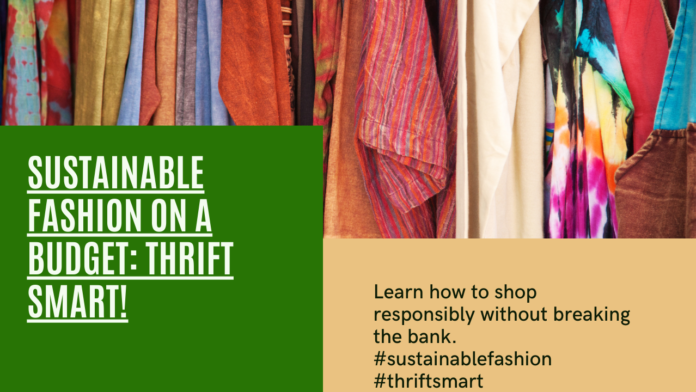Last Updated on April 1, 2024 by Silvy
Sustainable Fashion on a Budget? Thrift Smart!
Did you know that the fashion industry is one of the biggest contributors to global pollution? It produces 10% of the world’s carbon emissions and is responsible for 20% of global water pollution.
But here’s the good news – you can make a difference without emptying your wallet. Welcome to the world of sustainable fashion on a budget, where thrifting and secondhand shopping become the gateway to eco-friendly style.
Key Takeaways:
- Thrift stores and secondhand shopping offer affordable, eco-friendly clothing options.
- Sustainable fashion is about being mindful of both the environment and your budget.
- Thrifting allows you to reduce waste, carbon footprint, and support circular fashion.
- By repairing, upcycling, and building a capsule wardrobe with thrifted pieces, you can create a sustainable style you love.
- Online secondhand marketplaces provide convenient access to affordable, eco-friendly clothing.
Understanding Sustainable Fashion
Before we delve into the world of thrifting and secondhand shopping, it’s important to grasp the concept of sustainable fashion and its significance in the realm of eco-conscious living.
Sustainable fashion refers to clothing and accessories that are produced and consumed in a way that minimizes their environmental impact while promoting ethical practices throughout the supply chain. It involves considerations such as reducing waste, using eco-friendly materials, and ensuring fair labor conditions.
“Sustainable fashion is not just a trend; it’s a movement towards a more responsible and compassionate approach to fashion.”
With the increasing awareness of the detrimental effects of the fashion industry on the environment and communities, more and more people are embracing sustainable fashion as a means to make a positive change.
By choosing eco-friendly clothing options, we can reduce the demand for fast fashion, which often comes at a high cost to the planet and garment workers.
One of the key aspects of sustainable fashion is the focus on longevity. Instead of buying cheaply made garments that will quickly end up in landfill, sustainable fashion encourages us to invest in high-quality pieces that are designed to last. This not only reduces waste but also saves us money in the long run as we build a wardrobe of durable, timeless items.
The Three Pillars of Sustainable Fashion
- Environmental Impact: Sustainable fashion aims to minimize its impact on the environment by reducing carbon emissions, using eco-friendly materials, and implementing sustainable production processes.
- Social Responsibility: It involves ensuring fair wages and safe working conditions for garment workers, promoting transparency, and supporting artisans and local communities.
- Ethical Consumption: Sustainable fashion encourages conscious and mindful consumption, focusing on quality over quantity and making informed choices about the clothing we buy.
By embracing sustainable fashion, we not only contribute to a healthier planet but also support a more equitable and ethical fashion industry. Together, we can create positive change and make stylish choices that align with our values.
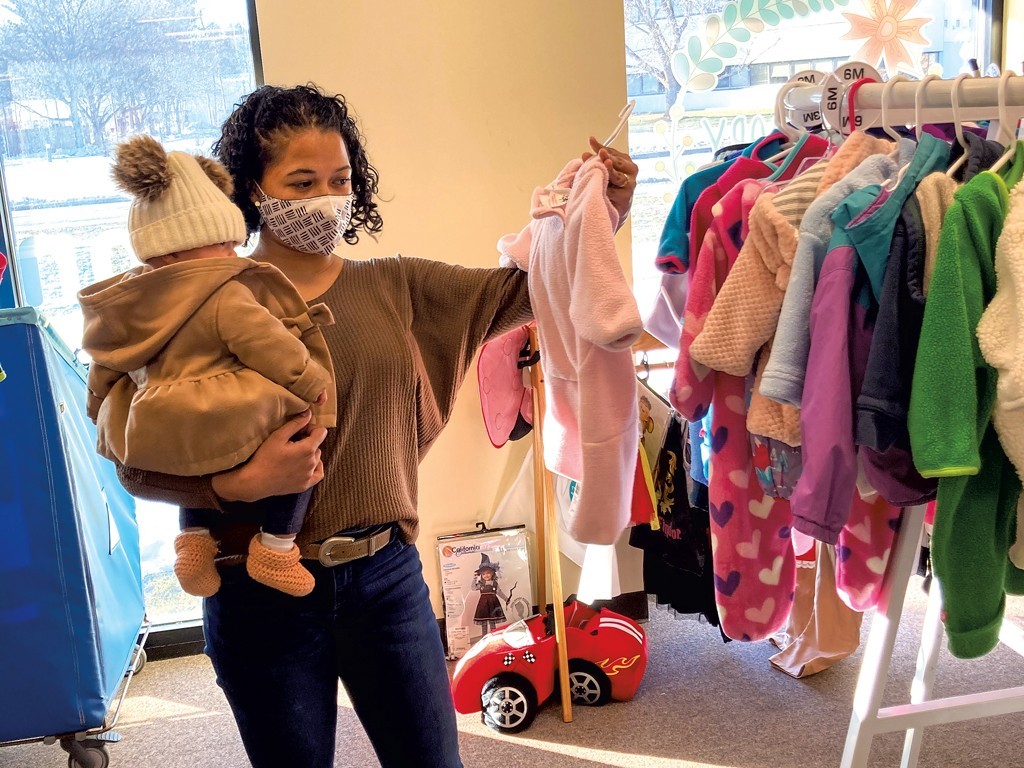
The Benefits of Thrifting and Secondhand Shopping
When it comes to sustainable fashion on a budget, thrifting and secondhand shopping are the way to go. Not only do these practices allow us to save money, but they also have numerous benefits for the environment and our personal style.
Let’s delve into why thrifting and secondhand shopping are the keys to achieving a budget-friendly sustainable style.
Reducing Waste and Carbon Footprint
One of the biggest advantages of thrifting and secondhand shopping is the significant reduction in waste and carbon footprint. By purchasing pre-loved clothing and giving it a second life, we divert items from the landfill and minimize the need for new clothing production.
Production of new clothing contributes to greenhouse gas emissions, water consumption, and other environmental impacts. Choosing thrifted and secondhand items means we’re not contributing to the demand for new garments, thereby reducing the overall carbon footprint of the fashion industry.
Supporting Circular Economy
Thrifting and secondhand shopping are a part of the circular economy, which aims to keep resources in use for as long as possible. When we buy secondhand clothing, we extend the lifespan of those items, creating a more sustainable fashion system.
Furthermore, when we donate or sell our gently used clothing, we contribute to the availability of affordable and sustainable fashion for others. It’s a win-win situation where everyone benefits from the cycle of reuse.
Saving Money
Another advantage of thrifting and secondhand shopping is the opportunity to save money. Secondhand items are often sold at significantly lower prices compared to their original retail value.
With a bit of patience and persistence, you can find high-quality clothing and accessories at a fraction of the cost. Thrifting allows us to explore a wide range of styles and brands without breaking the bank, making sustainable fashion accessible to everyone, regardless of their budget.
Unique and Individual Style
Thrifting and secondhand shopping also contribute to the development of our personal style. By shopping in secondhand stores, we can discover unique and one-of-a-kind pieces that add character to our wardrobe.
Unlike fast fashion, which often mass-produces generic styles, thrifting offers a diverse selection of clothing that allows us to express our individuality.
We can create looks that stand out and reflect our unique taste, all while promoting sustainable fashion.
Ethical Shopping
Choosing to shop secondhand aligns with our values of sustainability and ethical consumption. By supporting the secondhand market, we prioritize the reuse of resources and reduce the demand for new clothing production, which often exploits workers and degrades the environment.
“Thrifting and secondhand shopping not only make fashion affordable and accessible but also empower us to make conscious choices that promote a better future for the planet and the people.” – Emma Johnson
The benefits of thrifting and secondhand shopping are clear. By reducing waste, supporting the circular economy, saving money, embracing unique style, and aligning with ethical values, we can create a budget-friendly sustainable wardrobe without sacrificing fashion or the environment.
| Benefits of Thrifting and Secondhand Shopping | |
|---|---|
| Reduces waste and carbon footprint | |
| Supports the circular economy | |
| Saves money | |
| Allows for unique and individual style | |
| Promotes ethical shopping practices |
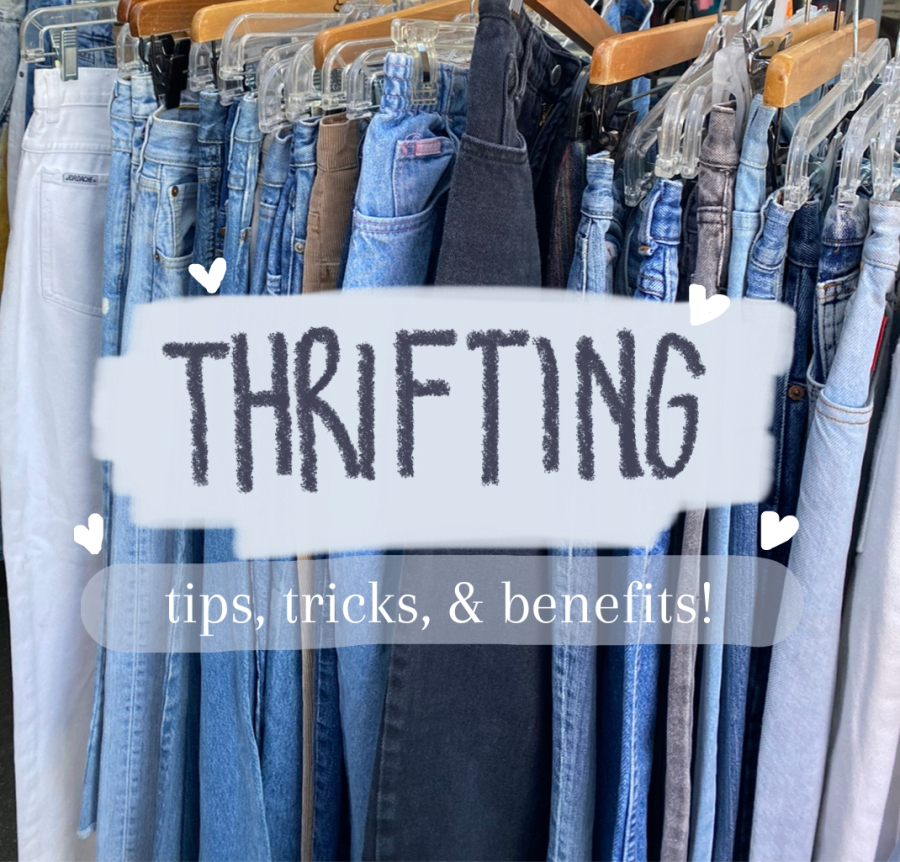
Thrifting Tips for Sustainable Fashion
When it comes to building a sustainable wardrobe on a budget, thrifting is a game-changer. Not only is it an eco-friendly way to shop, but it also allows you to uncover unique pieces that reflect your personal style.
To make the most of your thrifting journey, we’ve compiled some practical tips to help you navigate thrift stores effectively and find quality pieces that align with your sustainable fashion goals.
1. Do Your Research
Before heading to a thrift store, take some time to research the best ones in your area. Look for stores that have a reputation for carrying a wide selection of clothing items in good condition. Reading reviews or asking for recommendations from fellow thrifters can help you narrow down your options.
2. Be Patient and Persistent
Thrifting is like a treasure hunt – you never know what you’ll find. It’s essential to have patience and keep an open mind while browsing through racks of clothing. Some days you might strike gold, while other days might be less successful.
Don’t get discouraged; just remember that the thrill of the hunt is part of the fun.
3. Take Your Time
Thrifting requires a bit more time and attention compared to traditional shopping. Set aside a few hours to thoroughly explore the store, carefully inspecting each item. Look for quality fabrics, well-made stitching, and any potential flaws or damages.
Remember, a little TLC can often make a secondhand piece look as good as new.
4. Try Everything On
Don’t be afraid to try on different styles and sizes when thrifting. Sizing can vary across brands and decades, so be open to experimenting.
Trying on clothes will give you a better idea of how they fit and whether they flatter your body shape. It’s a great way to discover unexpected gems that may have been overlooked on the hanger.
5. Mix and Match
Thrifting allows you to build a wardrobe filled with unique pieces from different eras and styles. Embrace the opportunity to mix and match items to create your own fashion statement.
Pair vintage blouses with modern skirts, or layer a classic denim jacket over a trendy dress. The possibilities are endless!
“Thrifting is not just about finding affordable clothing; it’s about joining a sustainable fashion movement. Each thrifted piece we choose helps reduce waste and contributes to the preservation of our planet.” – Unknown
6. Consider Alterations
Don’t shy away from pieces that aren’t the perfect fit. Remember that alterations can often transform a thrifted find into a personalized masterpiece.
Whether it’s a simple hemming or taking in a waistline, a skilled tailor can bring new life to a pre-loved garment, making it uniquely yours.
7. Stay Organized
As you navigate through thrift store aisles, it’s easy to get overwhelmed by the sheer volume of clothing. To stay organized, have a clear list of items you’re searching for and prioritize your must-haves. This will help you stay focused and make your thrifting experience more efficient.
8. Shop Regularly
Thrifting is all about serendipity, so make it a habit to visit your favorite thrift stores regularly. New items are constantly being added to the racks, and you never know when you might stumble upon a hidden gem.
By becoming a regular shopper, you increase your chances of finding unique pieces for your sustainable wardrobe.
By implementing these thrifting tips, you’ll have the knowledge and strategies to build a sustainable wardrobe on a budget. Thrifting not only allows you to express your personal style but also helps reduce the fashion industry’s environmental impact.
Embrace the art of thrifting and create a wardrobe that’s as unique as you are while supporting a sustainable future.
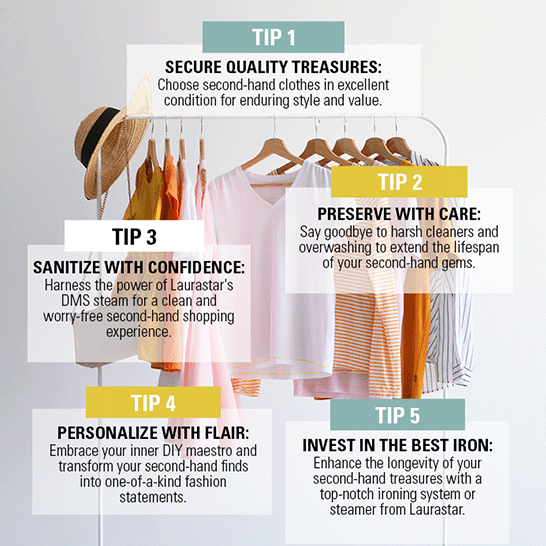
Secondhand Shopping Hacks
When it comes to secondhand shopping, it’s essential to have a few tricks up your sleeve to score the best deals and unearth hidden gems. We understand that sustainable fashion on a budget requires a strategic approach.
So, we’ve gathered some insider hacks and strategies to level up your secondhand shopping game.
1. Scout Thrift Stores Strategically
Not all thrift stores are created equal. Some are more likely to have a curated selection of quality secondhand items. Research which stores in your area have the best reputation and selection.
Look for those known for receiving regular donations from fashion-forward communities. These stores often carry trendy pieces at affordable prices.
2. Regularly Check for New Arrivals
Thrifting is all about timing. Make it a habit to visit your favorite thrift stores often, as new arrivals can come and go quickly. Most thrift stores have set days for new inventory, so be sure to find out when these days are and plan your visits accordingly.
This way, you’ll have the best chance of snagging unique items before someone else does.
3. Use Your Smartphone Wisely
Bring your smartphone with you while secondhand shopping to aid your decision-making process. Take advantage of fashion apps that can help identify designer pieces or provide information on fair pricing.
Additionally, use your phone to search for styling inspiration or to compare prices with similar items online.
4. Don’t Be Afraid to Negotiate
Thrifting is the perfect opportunity to practice your negotiation skills. While some thrift stores have fixed prices, others may be open to bargaining.
If you find a piece that you love but feel it’s priced too high, politely ask if they would consider lowering the price. You may be surprised by how often thrift stores are willing to negotiate.
5. Explore Garage Sales and Flea Markets
Don’t limit your secondhand shopping to just thrift stores. Garage sales and flea markets can also be treasure troves for budget-friendly sustainable style. These places often offer unique and one-of-a-kind items at bargain prices.
Keep an eye out for neighborhood or community events where multiple sales or markets are happening in one area.
| Hack | Description |
|---|---|
| Scout Thrift Stores Strategically | Research and visit thrift stores known for quality and fashion-forward donations. |
| Regularly Check for New Arrivals | Make frequent visits to thrift stores and find out when new inventory arrives. |
| Use Your Smartphone Wisely | Utilize fashion apps and your phone’s search capabilities for information and inspiration. |
| Don’t Be Afraid to Negotiate | Practice your negotiation skills and ask thrift stores for a lower price on items you love. |
| Explore Garage Sales and Flea Markets | Expand your secondhand shopping options by checking out garage sales and flea markets for unique finds. |
These secondhand shopping hacks can help you navigate the world of sustainable fashion on a budget.
Whether you’re searching for timeless pieces or on-trend fashion, mastering these strategies will ensure you find affordable and eco-friendly clothing that aligns with your style and values.
Exploring Online Secondhand Marketplaces
With the rise of sustainability and conscious consumerism, secondhand shopping has become more popular than ever. Thanks to online platforms, finding affordable and eco-friendly clothing options is now easier than ever before.
In this section, we’ll dive into some of the most popular online secondhand marketplaces where you can discover a treasure trove of pre-loved items that align with your sustainable fashion goals.
eBay
With its vast selection and broad user base, eBay remains one of the go-to destinations for secondhand shopping. From designer pieces to everyday essentials, you’ll find a wide range of options to suit your style and budget.
Take advantage of the bidding system and set your maximum bid to score a great deal on coveted items. Remember to check seller ratings and read product descriptions carefully before making a purchase.
Depop
Popular among fashion-forward millennials, Depop is a social shopping app that boasts a diverse community of sellers and buyers.
Whether you’re searching for vintage gems, trendy streetwear, or unique handmade pieces, Depop offers a wide variety of options. Make sure to follow your favorite sellers and engage with the community to discover hidden gems and stay up to date with the latest trends.
ThredUP
If convenience is your priority, ThredUP is the perfect online thrift store for you. Known as one of the largest online consignment and thrift stores, ThredUP features a curated selection of gently used clothing, shoes, and accessories for women, kids, and even men.
Take advantage of their search filters to refine your options by size, brand, and style, making it easy to find exactly what you’re looking for.
The RealReal
For those seeking luxury and high-end fashion at a fraction of the original cost, The RealReal is your destination. With a focus on authenticated luxury consignment, this online marketplace offers a curated selection of designer clothing, accessories, and even home decor items.
Indulge in the joy of owning luxury pieces ethically while saving money and reducing your environmental impact.
“Online secondhand marketplaces make sustainable and affordable fashion accessible to everyone. They offer a wide range of options, from everyday essentials to high-end designer pieces, catering to different budgets and styles.” – The Sustainable Stylist
By exploring these online secondhand marketplaces, you can discover a whole new world of sustainable fashion. Embrace the thrill of the hunt and revamp your wardrobe with unique and eco-friendly clothing choices.
Remember to thoroughly read product descriptions, check seller ratings, and engage with the community to ensure a successful secondhand shopping experience. Happy hunting!
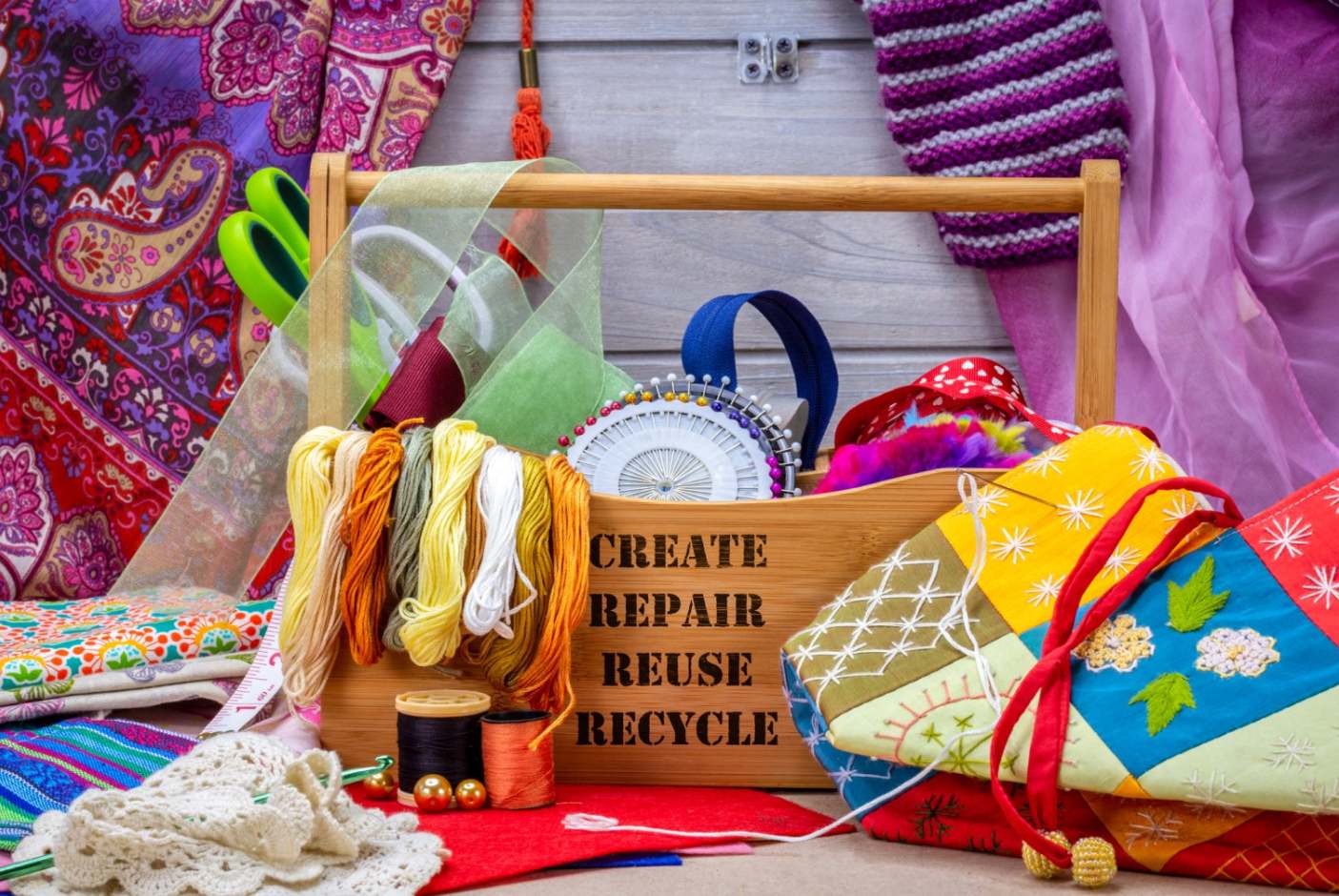
Repairing and Upcycling Pre-Owned Fashion
When it comes to sustainable fashion, the journey doesn’t end with buying pre-owned clothing. In fact, one of the most exciting aspects of secondhand shopping is the opportunity to repair and upcycle pre-owned fashion, giving it new life and making it your own.
By bringing our creativity and craftsmanship to the table, we can transform old garments into unique pieces that reflect our personal style.
Repairing damaged clothing is not only a sustainable practice but also a way to extend the lifespan of our favorite pieces. Simple tasks like stitching buttons, fixing loose hems, or patching up small tears can save garments from ending up in the landfill.
Not only do these repairs help us maintain a sustainable wardrobe on a budget, but they also allow us to hold onto cherished items with sentimental value.
Upcycling takes the concept of repair one step further. It involves repurposing clothing items that may no longer be wearable in their original form. With a little imagination, a dated dress can become a trendy skirt, or a worn-out pair of jeans can be transformed into a stylish tote bag.
Upcycling is all about getting creative and turning something old into something new and exciting.
The Art of Repairing and Upcycling
When it comes to repairing and upcycling pre-owned fashion, there are no hard and fast rules. It’s a chance to let our creativity run wild and experiment with different techniques and materials.
Here are a few ideas to get you started:
- Embroidery and Applique: Add decorative stitching or patches to conceal small holes or stains and give your clothing a unique touch.
- Dyeing and Printing: Transform faded or outdated items by dyeing them in vibrant colors or experimenting with fabric printing techniques.
- Cutting and Restyling: Give old clothes a fresh look by altering the silhouette, shortening or lengthening hemlines, or adding new details like ruffles or pleats.
- Combining and Layering: Mix and match different pieces to create new outfits, layering shirts, dresses, and skirts for a completely unique ensemble.
By embracing the art of repairing and upcycling pre-owned fashion, we not only reduce waste but also have the opportunity to express our personal style in a sustainable way.
Giving new life to old garments is a truly rewarding experience that allows us to create a wardrobe that reflects our values and showcases our unique fashion sense.
Upcycling is all about getting creative and turning something old into something new and exciting.
Example of Upcycling Transformation
 |
As you can see from the example above, a simple dress that was no longer worn was transformed into a chic top with a tie-front detail. By making some strategic cuts and adding a few stitches, the original garment was given new life and became a trendy piece that can be styled in various ways.
This is just one of the many possibilities when it comes to upcycling pre-owned fashion.
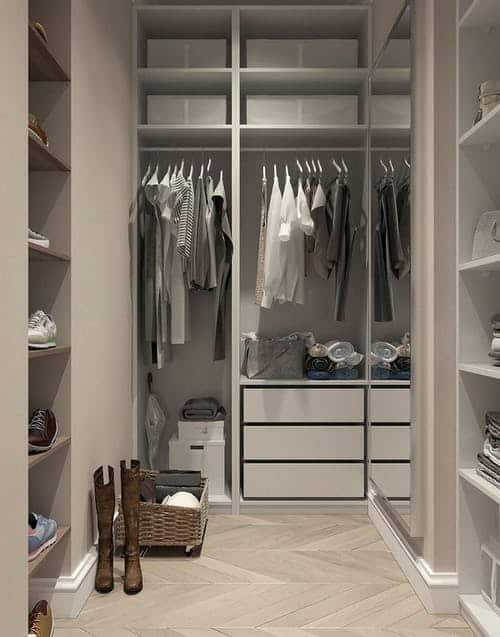
Building a Capsule Wardrobe with Thrifted Pieces
When it comes to achieving a sustainable wardrobe on a budget, building a capsule wardrobe using thrifted pieces is a smart and eco-friendly choice.
A capsule wardrobe follows a minimalist approach to fashion, focusing on quality and versatility. By curating a small collection of essential items, you can maximize your style potential while minimizing your environmental impact.
Thrifting plays a significant role in creating a sustainable capsule wardrobe. By finding secondhand gems, you not only reduce waste but also give pre-loved garments a new lease on life.
Here’s how you can create a capsule wardrobe that reflects your style and values:
Select Your Staples
Start by identifying the key pieces that form the foundation of your wardrobe. These essentials should be versatile enough to mix and match, allowing you to create multiple outfits.
Look for timeless items like a little black dress, a well-fitted blazer, a classic white shirt, and a pair of high-quality jeans. When thrifting, keep an eye out for these staples.
Consider Your Color Palette
Choosing a cohesive color palette for your capsule wardrobe ensures that all pieces can be effortlessly mixed and matched. Opt for neutral colors such as black, white, gray, beige, and navy blue, which create a versatile base.
Occasionally, you can add a pop of color with a statement thrifted piece to infuse personality into your outfits.
Quality Over Quantity
When thrift shopping for your capsule wardrobe, prioritize quality over quantity. Inspect garments for any signs of wear, stains, or damage. Pay attention to the fabric composition and overall construction, as well-made items tend to last longer and retain their shape.
By investing in well-crafted secondhand pieces, you’ll have a capsule wardrobe that stands the test of time.
Accessorize Thoughtfully
Accessories can elevate any outfit, allowing you to express your personal style. Look for thrifted accessories like statement belts, scarves, and handbags that complement your capsule wardrobe. These small additions can create different looks and make your outfits feel fresh and polished.
Sustainable fashion doesn’t mean compromising on style or breaking the bank. With a thrifted capsule wardrobe, you can curate a collection of timeless, high-quality pieces that align with your values. The key is to be intentional in your choices and embrace the art of thrifting.
Example Capsule Wardrobe
| Item | Color | Description |
|---|---|---|
| Little Black Dress | Black | A versatile and timeless piece that can be dressed up or down for any occasion. |
| White Button-Up Shirt | White | A crisp and classic staple that pairs well with jeans, skirts, and blazers. |
| Skinny Jeans | Dark Blue | A well-fitted pair of jeans that flatters your figure and can be worn with various tops. |
| Tailored Blazer | Black | A structured blazer that adds a polished touch to any outfit, whether it’s for work or a social event. |
| Neutral Sweater | Beige | A cozy sweater that can be layered or worn on its own, perfect for colder days. |
| Statement Skirt | Print/Color | A thrifted skirt with a unique print or color to add interest and variety to your capsule wardrobe. |
| Ankle Boots | Brown | A comfortable and versatile pair of boots that can be worn with dresses, jeans, and skirts. |
| Tote Bag | Black | A spacious and practical bag for carrying your essentials, suitable for both work and casual outings. |
Remember, the key to building a sustainable capsule wardrobe with thrifted pieces is to be intentional and selective. Keep your wardrobe streamlined and curated, focusing on quality, versatility, and longevity.
By embracing thrifting and incorporating secondhand items into your clothing rotation, you’ll not only save money but also contribute to a more sustainable fashion industry.

Incorporating Sustainable Fashion Trends
When it comes to sustainable fashion, it’s important to stay in touch with the latest trends while maintaining our commitment to eco-consciousness. We believe that sustainable fashion can be both fashionable and budget-friendly, allowing us to express our personal style without compromising our planet.
One way to incorporate sustainable fashion trends into your wardrobe without breaking the bank is by opting for timeless pieces that stand the test of time.
These versatile items can be mixed and matched with other sustainable fashion staples to create various stylish looks. By investing in quality pieces that can be worn for multiple seasons, you’ll not only save money in the long run but also reduce your overall fashion waste.
For example:
Investing in a high-quality organic cotton white shirt can be a great foundation for various outfits. Pair it with a pair of sustainably sourced jeans and a statement belt for a casual chic look, or dress it up with a tailored blazer and elegant trousers for a professional ensemble. With just one shirt, the possibilities are endless!
Another way to incorporate sustainable fashion trends on a budget is by exploring thrift stores and secondhand marketplaces. These treasure troves of pre-loved fashion often hold unique and stylish pieces that perfectly align with current trends.
By giving these items a second life, you not only save money but also contribute to reducing textile waste in the fashion industry.
For inspiration:
Keep an eye out for timeless classics like vintage blazers, oversized denim jackets, and flowy midi dresses. These items never go out of style and can easily be styled with modern accessories to create trendy looks.
Additionally, consider renting clothes for special occasions. Renting platforms offer a wide variety of designer pieces at a fraction of the retail price.
You can rock the latest sustainable fashion trends without the hefty price tag, knowing that you’re minimizing your environmental impact by opting for a rental rather than purchasing something new.
Finally, don’t forget to get creative with your existing wardrobe. Mix and match items to create unique combinations and experiment with different accessories. By reimagining your current pieces, you can elevate your style and be on-trend without spending a dime.
Remember:
Sustainable fashion on a budget is all about making conscious choices. Prioritize quality over quantity, opt for timeless pieces, explore thrift stores and secondhand marketplaces, consider renting, and get creative with your existing wardrobe.
By doing so, you can embrace sustainable fashion trends without compromising your commitment to sustainability or your wallet.
| Tips for Incorporating Sustainable Fashion Trends |
|---|
| Invest in timeless pieces that can be mixed and matched. |
| Explore thrift stores and secondhand marketplaces for unique and stylish finds. |
| Rent clothes for special occasions to rock the latest trends without the hefty price tag. |
| Get creative with your existing wardrobe and experiment with different combinations and accessories. |

Tips for Donating and Selling Pre-Owned Clothing
As you embrace sustainable fashion, you’ll likely accumulate pre-owned clothing that no longer serves you. We understand that part of the thrifting and secondhand shopping experience is not only finding new treasures for yourself but also passing on the joy to others.
That’s why we wanted to provide you with some helpful tips for responsibly donating or selling your gently used items, ensuring they continue their sustainable fashion journey.
- Research Donation Centers: Before donating your pre-owned clothing, take the time to research local donation centers in your area. Look for organizations that align with your values and have a track record of responsibly handling donations. Some centers may specialize in specific items or cater to particular causes, such as shelters or job training programs.
- Check Acceptance Guidelines: Different donation centers have specific guidelines for accepting clothing donations. Check their website or give them a call to learn about any restrictions on the types of clothing they accept. Some centers may only take items in good condition, while others may accept clothing regardless of condition for recycling purposes.
- Make Sure Clothing is Clean and in Good Condition: To ensure your donations are well-received, take the time to clean and inspect the items you’re planning to donate. Wash or dry clean them as necessary, repair any minor damages, and make sure they are presentable and in good condition.
- Consider Local Charities: While national or international organizations are great choices for donating, consider supporting local charities as well. Local charities often have a direct impact on your community and can provide immediate assistance to those in need.
- Host a Clothing Swap: Another great option for giving pre-owned clothing a new home is to host a clothing swap with friends, family, or local community members. This way, everyone can exchange clothing items they no longer wear and find new treasures without spending a dime.
“Donating pre-owned clothing is a wonderful way to extend the life of garments and reduce environmental impact. It allows someone else to discover and enjoy your previously loved pieces, contributing to a more sustainable fashion industry.” – Thrifting Expert
If you prefer to sell your pre-owned clothing, there are various online platforms and consignment stores that make the process easy and convenient. Here are some additional tips for selling your gently used items:
- Research Selling Platforms: Look into popular online platforms and consignment stores that specialize in secondhand fashion. Each platform may have different fees, policies, and target audiences, so do your research to find the best fit for your selling needs.
- Take Quality Photos: When selling your clothing online, quality photos are crucial. Take well-lit, clear pictures that showcase the item’s details and accurately represent its condition. Including measurements and a detailed description can also help potential buyers make informed decisions.
- Pricing Strategically: Determine a fair and competitive price for your items. Consider their brand, condition, and original price when setting the price. You can also browse similar listings to get an idea of the market value for comparable items.
- Promote Your Listings: Don’t just rely on the platform to promote your listings. Utilize social media and personal networks to spread the word about your pre-loved items. Sharing high-quality photos and engaging captions can help generate interest and attract potential buyers.
- Package Items Securely: When it’s time to ship your sold items, make sure to package them securely. Use appropriate packaging materials to protect the garments during transit and include a handwritten thank-you note for a personal touch.
By responsibly donating or selling your pre-owned clothing, you not only contribute to a more sustainable fashion industry but also create opportunities for others to enjoy and embrace the thrifting and secondhand shopping experience.

Maintaining Your Sustainable Wardrobe
To make the most of your sustainable fashion on a budget, it’s essential to care for your clothing and accessories properly.
By incorporating sustainable laundry practices, implementing effective storage solutions, and exploring other eco-conscious maintenance strategies, you can prolong the lifespan of your garments while keeping your fashion choices budget-friendly.
Sustainable Laundry Practices
When it comes to sustainable fashion, the way you do your laundry matters. Opt for cold water whenever possible, as it saves energy and helps preserve the quality of your clothing.
Consider using eco-friendly detergent brands that prioritize biodegradable ingredients and minimal packaging. And don’t forget to air dry your clothes instead of relying on the energy-intensive dryer.
Storage Tips
Proper storage is key to maintaining the condition of your garments. Avoid hanging delicate items, like knits and silk, as it can stretch them out of shape. Instead, fold them neatly and place them in drawers or storage containers.
For heavier items like coats and jackets, invest in sturdy hangers to prevent any damaging creases. And when storing your shoes, keep them in a well-ventilated area to prevent moisture buildup.
Other Eco-Conscious Maintenance Strategies
Aside from laundry and storage, there are additional ways to ensure your sustainable wardrobe stays in great shape. Regularly check for loose threads or missing buttons and repair them promptly to extend the life of your clothing.
Embrace the art of upcycling and repurposing by transforming old pieces into new, trendy items. And when faced with tough stains, opt for natural stain removers like baking soda and white vinegar instead of chemical-laden alternatives.
| Tips for Maintaining Your Sustainable Wardrobe |
|---|
| 1. Wash your clothing in **cold water** to save energy and preserve quality. |
| 2. Use eco-friendly detergents that prioritize **biodegradable ingredients** and **minimal packaging**. |
| 3. Air dry your clothes instead of relying on the energy-intensive dryer. |
| 4. Fold delicate items and place them in drawers or storage containers to prevent stretching. |
| 5. Invest in sturdy hangers for heavier items like coats and jackets to prevent creases. |
| 6. Store your shoes in a well-ventilated area to prevent moisture buildup. |
| 7. Regularly check for loose threads or missing buttons and repair them promptly. |
| 8. Embrace upcycling and repurposing to give old pieces a new life. |
| 9. Use natural stain removers like baking soda and white vinegar. |
By incorporating these maintenance strategies into your daily routine, you can ensure that your sustainable fashion choices not only last longer but also stay within your budget.
Taking care of your clothing and accessories not only extends their lifespan but also reduces the need for continuous purchasing, contributing to a more sustainable and eco-conscious fashion industry.
Conclusion
In conclusion, embracing sustainable fashion on a budget can be both rewarding and impactful. By understanding the principles of sustainable fashion, such as reducing waste and promoting eco-consciousness, we can make thoughtful choices that benefit the planet and our wallets.
Thrifting and secondhand shopping are powerful tools in achieving this goal. By mastering the art of thrifting and incorporating secondhand items into our wardrobes, we can create stylish and unique looks without compromising our commitment to sustainability.
With the tips and tricks shared in this article, you have the knowledge and resources to build a sustainable wardrobe that reflects your values and helps protect the environment.
By shopping secondhand, repairing and upcycling pre-owned fashion, and embracing sustainable fashion trends, you can make a difference while staying within your budget.
So, let’s seize the opportunity to make a positive impact. Together, we can redefine our relationship with fashion and pave the way for a more sustainable and stylish future.
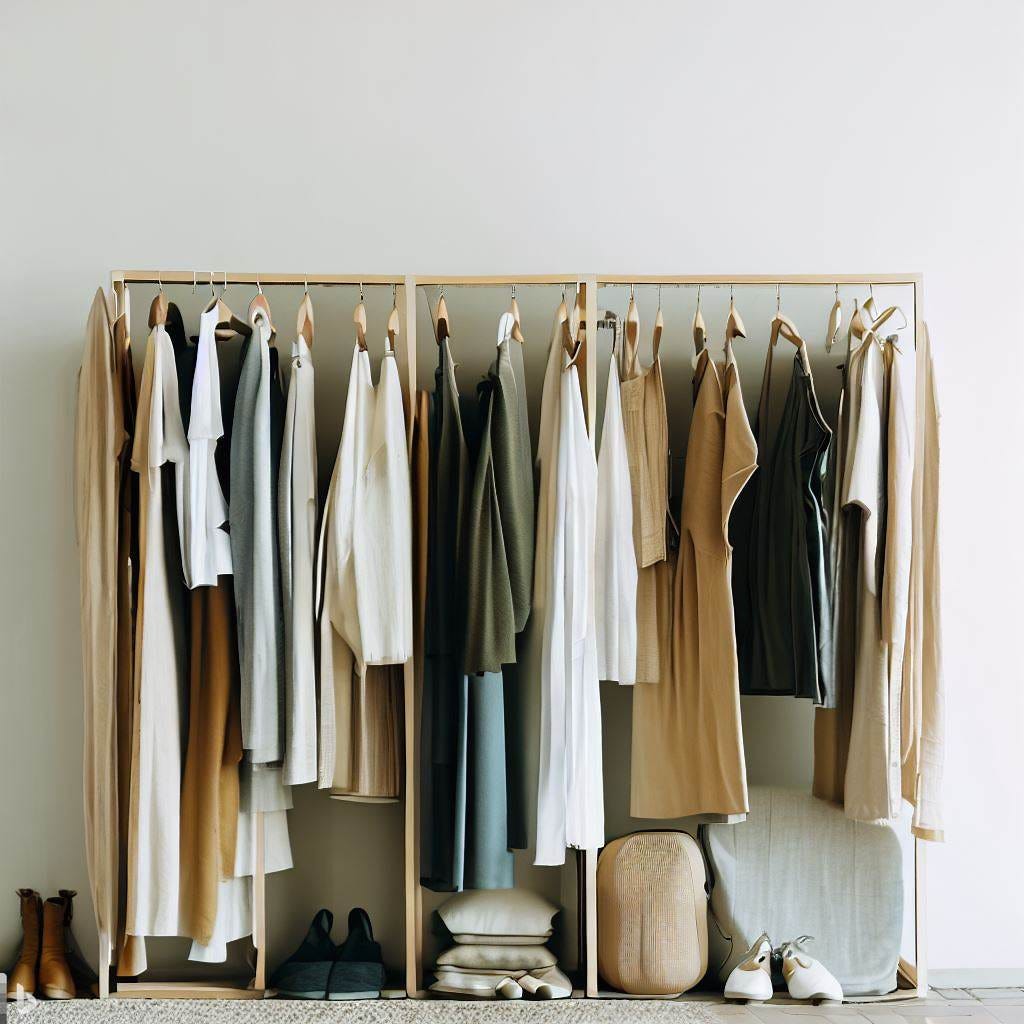
FAQ
Can I find affordable sustainable fashion on a budget?
Absolutely! Thrifting and secondhand shopping are great ways to achieve a sustainable fashion wardrobe without breaking the bank. By buying pre-owned clothing, you can save money while also reducing waste and supporting a circular fashion economy.
What is sustainable fashion and why is it important?
Sustainable fashion refers to clothing and accessories that are produced with minimal impact on the environment and uphold ethical labor practices. It’s important because the fashion industry is a significant contributor to pollution and waste. Embracing sustainable fashion helps reduce carbon footprint, promote fair treatment of workers, and preserve natural resources.
What are the benefits of thrifting and secondhand shopping for sustainable fashion?
Thrifting and secondhand shopping have multiple benefits. They help reduce clothing waste, support the recycling of garments, and minimize the environmental impact of fashion production. Additionally, shopping secondhand often allows you to find unique, one-of-a-kind pieces that add individuality to your wardrobe.
Do you have any thrifting tips for building a sustainable wardrobe on a budget?
Certainly! When thrifting, it’s helpful to have a clear idea of what you’re looking for, prioritize quality over quantity, and consider alterations to tailor items to your style. Additionally, exploring thrift stores in different neighborhoods or online can expand your options and increase your chances of finding hidden gems.
How can I make the most of my secondhand shopping experience?
To optimize your secondhand shopping, try visiting thrift stores during off-peak hours to avoid crowds, inspect items carefully for any damages, and consider negotiating prices when applicable. It’s also beneficial to have a list of specific items or styles you’re interested in, but remain open to unexpected finds.
What are some popular online secondhand marketplaces for affordable eco-friendly clothing?
There are several popular online platforms where you can find affordable, eco-friendly clothing. Some popular ones include ThredUp, Poshmark, Depop, and eBay. These platforms offer a wide range of pre-owned clothing options that cater to different styles and budgets.
How can I repair and upcycle pre-owned fashion to give it new life?
Repairing and upcycling pre-owned fashion is a sustainable way to extend the life of clothing. You can mend small tears or loose buttons, transform garments into new pieces, or customize them with embroidery or dye. With a little creativity, you can make pre-owned fashion truly unique and suited to your style.
Is it possible to build a sustainable wardrobe using only thrifted pieces?
Absolutely! Building a sustainable wardrobe doesn’t have to mean exclusively buying new items. Thrifting allows you to find high-quality, unique pieces while minimizing your environmental impact. By focusing on versatile basics and mixing and matching, you can create a sustainable capsule wardrobe using predominantly thrifted pieces.
Can I follow current fashion trends while embracing sustainable fashion on a budget?
Yes, you can incorporate sustainable fashion trends into your wardrobe without compromising your commitment to sustainability or your budget. Look for thrifted or secondhand items that reflect current trends or find ways to style existing pieces to achieve a similar look. It’s all about being creative and resourceful!
What should I do with pre-owned clothing that no longer serves me?
When you no longer need pre-owned clothing, it’s important to responsibly donate or sell it. Look for local charities or thrift stores that accept donations or consider selling items online through platforms like Poshmark, eBay, or Facebook Marketplace. By passing on your pre-loved items, you can continue their sustainable fashion journey.
How can I properly care for my sustainable wardrobe?
Proper care is essential to maintain a sustainable wardrobe. Follow sustainable laundry practices, such as washing clothes in cold water and air-drying whenever possible. Store your garments in a way that prevents damage and consider using natural products for stain treatment and garment care. By treating your clothing with care, you can extend its lifespan and minimize the need for replacements.
Reference Links:
- Sustainable thrifting tips: https://www.angiebetancourt.com/lifestyle/top-10-thrifting-tips-for-sustainable-and-stylish-shopping/


